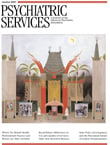Matching Patients and Providers Across the United States
In this issue three articles from the University of North Carolina's Sheps Center provide new county-level estimates of the number of persons with mental illnesses, the number of mental health care providers, and the number of counties in which the shortage of providers indicates unmet needs. If health care coverage is expanded at the national level as a result of reform, these estimates may take on greater relevance. Over three-quarters of counties were found to have a severe shortage of prescribers, with more than half of the need unmet. Mental health prescribers are currently represented by an estimated 32,000 psychiatrists and 8,000 advanced practice nurses nationwide. Not surprisingly, needs are higher in poorer, more rural counties, especially those in the center of the country.
Several interesting trends emerge. Current service use is not overly generous: persons with serious mental disorders spend less than five hours per year with the clinician prescribing their medications, and persons with less serious disorders spend less than 15 minutes. Half of all marriage and family therapists are in California, which suggests that practice niches can grow when a subculture develops a demand for a particular service. Previous research has shown that psychiatrists are older on average than other mental health providers. Thus, over the next decade the proportion of psychiatrist providers will decline, which will increase the demand for prescriptions from nurses and other medical professionals and reopen issues about prescription by psychologists. However, prescribing by psychologists may not increase services in the poorer counties that are most in need, because the correlation between per capita county income and the concentration of psychiatrists (r=.43) is lower than that for psychologists (r=.49).
The conclusions are provocative because the authors advocate for demedicalization of psychiatric practice to address unmet needs. However, critical data are lacking. For example, there is no analysis of how counties are meeting their other health needs, such as those that involve other physician specialties. If psychiatrists are specifically in short supply because they are underpaid relative to other physicians, then the "aging out" of psychiatrists may reflect an inequity in reimbursement for their services that should be corrected by better parity mandates. On the other hand, if poorer counties are also underserved by physicians in general, then incentives to practice in poorer, more rural counties should be considered. There is also no analysis of the quality of care. The November 2006 issue of the American Journal of Psychiatry included a report of county-level data that linked improved antidepressant prescribing practices to lower adolescent suicide rates and that showed service issues in rural middle America. It would be wise to consider effectiveness of care as well as costs in future health services decisions.



